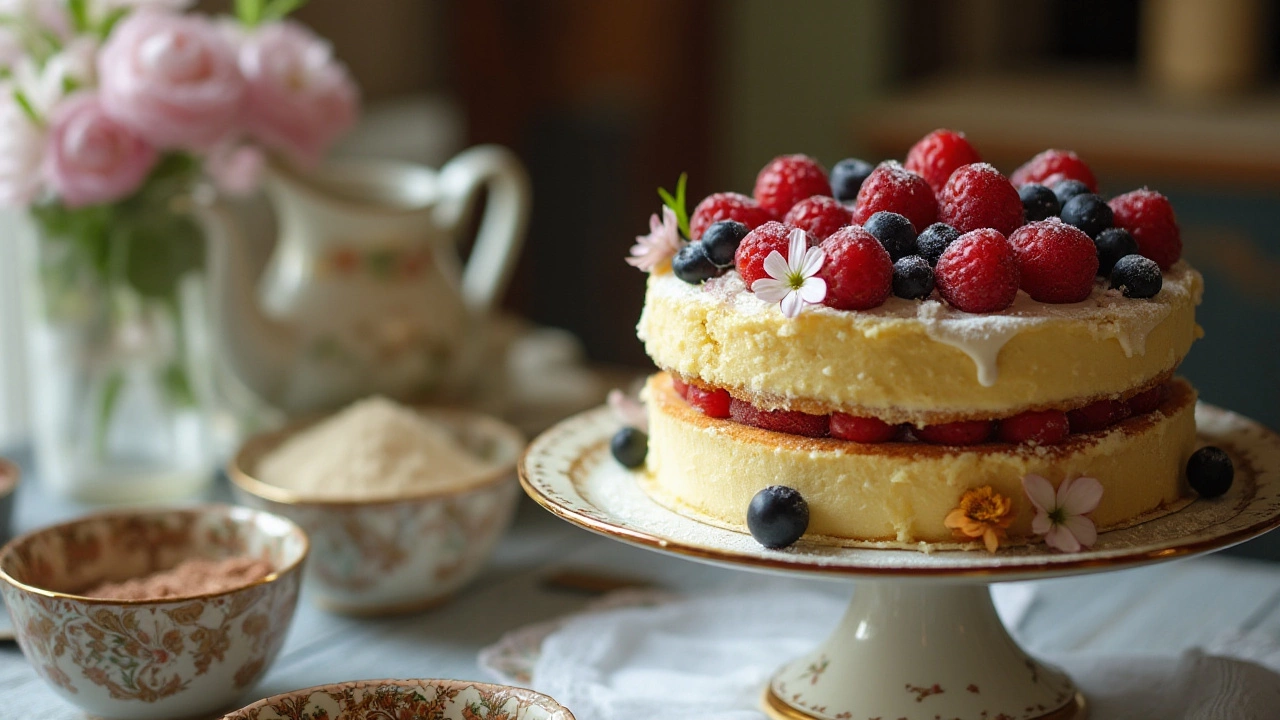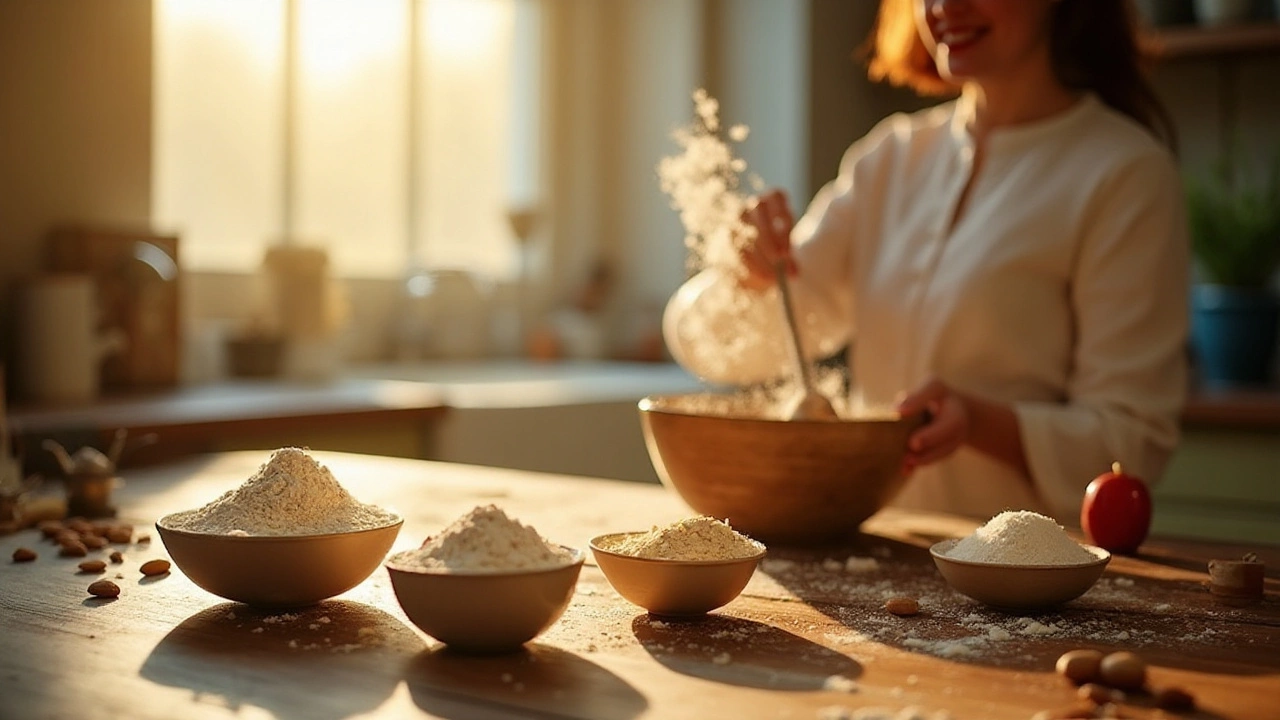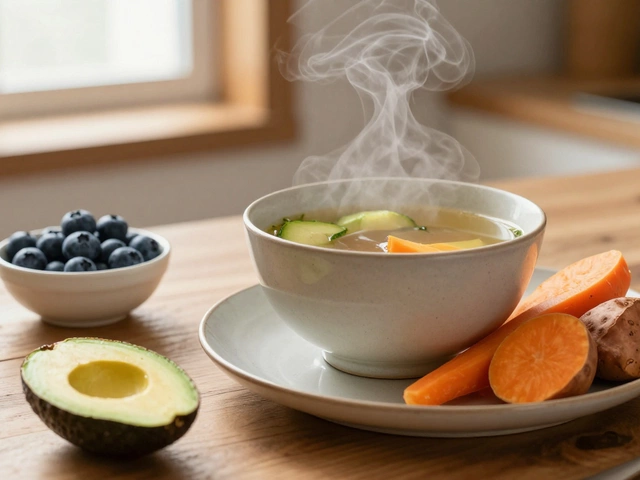Baking a cake without using gluten sounds challenging, but it's more than possible with a bit of creativity and the right ingredients. For those navigating gluten intolerances or simply exploring new flavors, alternative flour options offer exciting possibilities. With gluten-free baking becoming increasingly popular, understanding these substitutes allows for creations that are not just edible but truly enjoyable. From almond and coconut flours to the more subtle rice flour, each brings its own flair to the baking table.
Embarking on a gluten-free baking adventure means expanding your pantry and palate. With different textures and tastes, each flour has its own strengths. This culinary journey invites enthusiasm and readiness to experiment, ensuring that every cake is not just a recipe, but a delightful experience. Let’s dive into these diverse flours and see how they can transform your gluten-free cakes into showstoppers.
- Understanding Gluten-Free Flour Options
- Almond Flour: A Nutty Alternative
- Coconut Flour's Unique Characteristics
- The Versatility of Rice Flour
- Blending Flours for Better Texture
- Tips for Gluten-Free Cake Baking Success
Understanding Gluten-Free Flour Options
Embarking on the journey of gluten-free baking opens up a world of exciting flour alternatives that not only serve as substitutes but also add unique flavors and textures to your cakes. The absence of gluten, a protein found in wheat that provides elasticity and strength to dough, poses the question of how to replicate this structure using other flours.
One of the most appealing aspects of gluten-free flours is the array of flavors they bring to your baking repertoire. For instance, almond flour lends a subtle sweetness and a moist crumb to your bakes, perfect for creating a rich and flavorful base, whereas coconut flour brings a hint of tropical flair with its unique ability to absorb moisture, making it crucial to balance liquids in your recipe. Additionally, rice flour provides a neutral taste, which is a versatile addition to any gluten-free baking pantry. Did you know that each cup of almond flour contains about 90 almonds? That adds a nutty power punch of flavor to your cakes!
Nancy Silverton, an acclaimed chef, has noted, "The secret to great gluten-free baking is understanding each flour’s unique properties and how they interact with other ingredients."
Creating the perfect gluten-free cake often involves blending different flours to mimic the properties of traditional wheat flour. A strategic combination can yield a more balanced flavor profile and better texture. Many bakers find success in mixing rice flour with potato starch or tapioca flour for a lighter crumb, while some prefer to incorporate sorghum flour for its earthy sweetness and fine texture.
While experimenting with gluten-free flours, it's important to consider the nutritional aspects as well. For example, almond flour is packed with protein and healthy fats, ideal for those seeking nutritious baking options. On the other hand, coconut flour is high in fiber, requiring less quantity in recipes but more experimentation to find the right moisture balance. A certain charm of gluten-free baking lies in these discoveries and customization opportunities, ensuring that each cake is not just free of gluten, but full of character.
Here's a simple guide to understanding these flours better:
- Almond Flour: Offers a nutty flavor, high in protein, and good for moisture-rich cakes.
- Coconut Flour: High in fiber, absorbs more liquids, and adds a subtle sweetness.
- Rice Flour: Neutral taste, good for binding in blends.
- Sorghum Flour: Adds sweetness and fine texture.
Though navigating through gluten-free ingredients may seem daunting at first, patience and practice will lead you to concoct cakes that are not only structurally sound but also delightful to the palate. By embracing the diversity of gluten-free flours, we open doors to new flavors and culinary adventures, proving that gluten-free baking is an art in its own right.
Almond Flour: A Nutty Alternative
Almond flour is a standout option for those seeking a gluten-free flour that adds both flavor and nutrition to their cakes. Made from finely ground blanched almonds, this flour brings a rich, buttery taste to baked goods and delivers a moist texture that is often missing in other gluten-free substitutes. Almond flour's naturally nutty essence enhances the sweetness of cakes, making it a favorite among bakers looking to infuse their creations with a unique twist.
Besides its distinctive taste, almond flour is packed with nutrients. It is rich in healthy fats, protein, and vitamin E, which are all beneficial for overall well-being. These nutritional perks make almond flour an excellent choice not only for gluten-free baking but also for adding a wholesome touch to recipes. It's not just about flavor; the presence of antioxidants in almond flour contributes to its appeal as a healthier baking ingredient.
When using almond flour, it's important to consider its texture. Because it lacks gluten, which provides structure to baked goods, almond flour can lead to denser cakes. However, this can be counterbalanced by incorporating eggs or other binding agents, which help achieve a light and fluffy texture. An understanding of its properties is key to successful baking, ensuring your cakes rise to the occasion and delight with every bite.
An interesting tip about using almond flour in cake recipes is to combine it with tapioca or arrowroot flour. These starches can help improve the elasticity and give your cake that perfect crumb. Additionally, because almond flour absorbs moisture differently than wheat flour, it may be necessary to adjust the liquid ingredients in your recipes. The moisture retention of almond flour ensures the cakes remain tender and sumptuous longer.
"Almond flour is one of those ingredients that, once you try it, you may never go back," says renowned pastry chef Christina Tosi. "It's a total game-changer in gluten-free baking."
Adding almond flour to your gluten-free cake repertoire also contributes to lower carbohydrate content, making it a popular choice for those following paleo or low-carb diets. This versatility underscores almond flour's role as not just a gluten-free substitute but as an ingredient that caters to various dietary preferences without sacrificing flavor or texture. With a little experimentation, incorporating almond flour can elevate your cake-making to delightful new heights.

Coconut Flour's Unique Characteristics
Diving into the world of gluten-free flour options, coconut flour stands out with its distinctive qualities and impressive versatility. Harvested from the dried meat of coconuts, this flour brings a subtle sweetness and a mild coconut aroma which complement rich flavors superbly. One can't help but marvel at how this ingredient, despite its tropical association, can elevate the simplest cakes.
First and foremost, coconut flour is incredibly absorbent. It's known to soak up moisture rapidly, which means recipes need to include significant adjustments for liquid ingredients. The addition of extra eggs or other binding agents is often necessary to prevent the final product from turning out too dry. Its high fiber content not only contributes to its absorbency but also makes it a nutritious ingredient choice. Rich in dietary fiber, each serving can contribute to better digestion and promote a feeling of fullness without a hefty calorie count.
Interestingly, it's also naturally gluten-free while providing a wealth of nutritional benefits similar to other alternative flours like almond flour. As a low-carb substitute, it’s rapidly becoming a favorite among those following paleo or keto diets. Coconut flour has double the fiber compared to wheat flour, and it also boasts a notable amount of protein, helping to enrich gluten-free recipes with added nutritional goodness.
“Coconut flour may require a bit of experimentation, yet the rewards in terms of flavor and nutrition are worth it,” says nutritionist Gillian McKeith, emphasizing its status as a staple in her gluten-free pantry.
Despite its delicate appearance, coconut flour can at times be tricky to work with due to its density, which can make it challenging to replace wheat flour one-to-one in recipes. When converting recipes, a useful guideline is to use only about one quarter to one third the amount of coconut flour compared to wheat flour, while also increasing the number of eggs for better binding. But once you find that perfect balance, the results can be staggeringly delightful.
For bakers eager to experiment, the combination of coconut flour with other gluten-free flour variants like almond or rice flour can help create a more balanced texture in cakes and other baked goods. This blend not only alleviates the overly dense results but also opens up a world of flavor possibilities. With the right approach and understanding of its quirks, coconut flour becomes a powerful ingredient in the quest to create sumptuous gluten-free cakes.
The Versatility of Rice Flour
Rice flour, a staple in numerous culinary traditions around the world, stands out for its unique properties, making it a well-loved choice for those exploring the realm of gluten-free baking. Its subtle flavor and fine texture provide a welcome versatility when crafting cakes and desserts that don’t rely on gluten. The beauty of rice flour is its ability to blend seamlessly into a variety of recipes, while offering a satisfying crumb and lightness to cakes. This makes it an excellent option not just for gluten-free enthusiasts, but also for anyone looking to create delightful and different baked goods.
One of the interesting aspects of rice flour is its light texture, which contributes to creating airy batters with an appealing soft crumb in cakes. It absorbs moisture beautifully, resulting in bakes that are tender yet structured. For bakers, this characteristic means experimenting with rise and consistency without fear of a stodgy outcome. Interestingly, rice flour is a common choice among bakers who aim to keep their gluten-free flour options uncomplicated yet effective. Notably, rice flour can be derived from white or brown rice, providing options that are both nutritionally different and texturally unique. The latter often retains more fiber, adding a wholesome touch to home-baked treats.
The inclusion of rice flour in baking goes beyond just cakes. It is frequently used in traditional dishes in different cultures, such as the sweet Japanese mochi or the velvety batter of South Indian dosas. Gluten-free flour blends often include rice flour due to its ability to mimic the lightness and texture of wheat-based products seamlessly. As such, it has become a go-to staple in many kitchens. Its appeal lies not only in its adaptability but also in its relative ease of obtaining and affordability, making it accessible for all sorts of culinary experiments. For motivated bakers aiming to broaden their horizons, understanding how rice flour interacts with other ingredients is a rewarding adventure.
According to the Harvard School of Public Health, 'Refined grains like white rice are generally less nutritious than whole grains, but in moderation, can contribute to a balanced and satisfying diet.'
The benefits of using rice flour extend to health-conscious bakers who wish to create lower-calorie and hypoallergenic recipes. Although lacking the gluten's elasticity and structure, rice flour can easily be balanced with other alternative flours such as almond or coconut for improved texture and flavor. For optimal results, consider experimenting with a mix of rice flour and starches like tapioca or potato starch, which can further mimic the traditional elasticity offered by gluten. This allows for customization according to taste preference and dietary goals, offering a creative element to each bake.
Incorporating rice flour into gluten-free recipes can transform the way you approach baking, turning perceived limitations into opportunities for innovation. To start, try using it as a base in a classic vanilla or chocolate cake recipe, adjusting the liquid content slightly to get the right consistency. By embracing its characteristics and blending with others, rice flour becomes a silent hero in crafting cakes that are as beautiful as they are delicious, honoring both tradition and modern dietary preferences. It inspires a sense of versatility and adaptability, essential traits for any culinary artisan willing to explore the dynamic world of gluten-free baking.

Blending Flours for Better Texture
When embarking on the journey of gluten-free baking, one soon realizes that achieving the perfect texture is as much an art as it is a science. While a single type of gluten-free flour can stand alone, blending different flours often yields superior results. Baking with blends allows each flour to complement the others, much like instruments in an orchestra, creating a harmoniously textured cake. Almond flour, with its moist and nutty characteristics, when combined with the absorbent nature of coconut flour, can create a well-balanced cake with just the right crumb. The use of rice flour, known for its neutral taste and fine texture, can also help lighten up the heaviness that nut-based flours sometimes bring.
Combining different alternative flours can be likened to mixing various shades to achieve the perfect paint color. It allows bakers to offset the weaknesses of one flour with the strengths of another. For example, coconut flour's intense absorptive qualities mean it requires more liquid in recipes, but when blended with oat or tapioca flour, it maintains moisture without demanding excessive eggs or liquid, which could weigh down the cake. The gluten-free bakers' community often suggests that such creative exploration yields the most delightful results. As food writer and culinary educator Peter Reinhart aptly puts it, "Baking is both a science and an art; when we engage both aspects, we can create something truly special."
"Focusing on the interaction of multiple flours can unlock flavors and textures that a single flour alone cannot provide." - Reena Gurbaksh, Culinary Chef and Gluten-Free Specialist.
To better understand the potential combinations, consider how different gluten-free flours behave together. A mix of sorghum flour and tapioca starch is often used to mimic the elasticity typically provided by gluten. Sorghum brings a mild, sweet flavor and a smooth texture, while tapioca contributes chewiness and holds ingredients together. Combining these can result in a cake that is both structurally sound and palatable. It's this balance of flavors and textures that highlights the unique role each ingredient plays. Each flour offers unique characteristics, and balancing these in combinations - such as chickpea flour for a bit more protein and structure or potato starch for added lightness - enhances the overall texture and makes for a well-rounded culinary experience.
Successful gluten-free baking with flour blends also involves trial and error, and it requires adjusting to personal taste and dietary needs. Proportions matter, and most blends work best when at least three types of flour are used to achieve a balance of texture, taste, and nutritional content. A common blend might consist of 40% whole grain flour, 30% starchy flour, and 30% neutral flour. Don't hesitate to experiment with different ratios until the desired level of lightness and moisture is achieved. The artistry lies in the gradual experimentation and the patient tweaking of proportions as bakers get familiar with how these unique flours interact.
Understanding moisture absorption is critical when blending flours. Each flour absorbs moisture differently, and the right combination results in cakes that are moist without being soggy, maintaining structure without being dry or crumbly. Replacing wheat flour with just one alternative may lead to unsatisfactory results, but a well-thought-out blend allows the baker to pivot around the unique absorbency levels and flavors, ensuring each bite is pleasantly moist and flavorful. These diverse blends can transform any basic recipe into a delightfully fluffy cake that can hold its own against any traditional gluten cake. Finally, it's the journey of discovery and refinement in gluten-free cake making that opens up a world of flavors, making it not just a necessity for some, but a preference for many.
Tips for Gluten-Free Cake Baking Success
Gluten-free cake baking is not just about swapping out flours; it's about understanding and embracing the nuances that alternative flours bring to your kitchen. When embarking on the journey of gluten-free cake creation, pay attention to how you maintain moisture in your cakes. Many gluten-free flours, such as coconut flour, are far more absorbent than traditional flour. This means your batter could become dry if you're not careful about balancing with adequate liquids, such as oil, egg, or milk alternatives.
A secret to success is mastering the art of blending flours. Many bakers have found that a single gluten-free flour often lacks the elasticity and binding properties needed. Combining, say, almond flour with a starchy flour like tapioca can mimic the qualities of gluten and improve the texture of your cakes. Using a flour blend not only enhances texture but also adds depth to the flavor of the cake itself. Find a combination that works best with your palate.
"Gluten-free baking is about creating balance and harmony between textures and flavors," says renowned baker Sarah Black. "A little experimentation goes a long way in baking the perfect gluten-free cake."
Let's not forget about leavening agents. Given that gluten-free cakes may not rise as compared to those made with traditional flour, incorporating more leavening can be beneficial. Baking powder and soda are your friends here. It's important to keep a watchful eye, as too much can negatively affect the taste, often leaving a subtle aftertaste. Subscription to trial and error will serve well here, ironing out kinks with each attempt.
Mind the mixing process too. Over-mixing your batter can result in a dense cake, which is precisely what you want to avoid. Be gentle when combining wet and dry ingredients, using a soft folding technique instead of vigorous stirring. This will help keep the air in the batter, making for a lighter, fluffier cake. For precision, invest in quality measuring tools. Accurate measurements can significantly affect the outcome of your baked goodies. Baking, especially gluten-free, is akin to a science, and precision makes a difference.
Last but not least, always give your gluten-free baking efforts a solid test run. Baking times and temperatures sometimes vary, and having a trial run will help you gauge the exact needs of your oven. Remember to cool completely before icing, as gluten-free cakes tend to be more fragile and are more apt to crumble when they’re warm. Whether you're making a birthday bash masterpiece or a casual tea-time cake, these tips will put you on the path to success.




